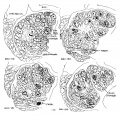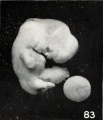Search results
From Embryology
- ===All Carnegie Embryos listed=== [[Category:Carnegie Embryo 6]]5 KB (496 words) - 11:36, 29 July 2018

File:Wen1928-Fig18.jpg ==Fig. 18. Camera-lucida drawings from sections 179 to 182 of H951== [[Category:Carnegie Embryo 4315]](1,000 × 962 (331 KB)) - 15:32, 21 April 2016- ...em]][[Category:Carnegie Stage 18]][[Category:Carnegie Stage 10]][[Category:Carnegie Stage 20]]</noinclude>708 bytes (86 words) - 18:13, 16 March 2020

File:Mall Meyer1921 fig83.jpg ==Fig. 83. Normal embryo with cyclopia== ...Cyclopia in the human embryo. Contributions to Embryology, No. 15, vol. 6, Carnegie Inst. Wash. Publication 226, p. 5-33. 12, 148, 163, 201, 391, 470, '''559''(464 × 542 (35 KB)) - 05:46, 4 December 2012- ...function of long noncoding RNAs (lncRNAs) and small RNAs during oocyte-to-embryo transition in mammals. LncRNAs are an assorted rapidly evolving collection ...miR-183) are differentially expressed in the CVG compared to NC and OV at Carnegie developmental stage {{CS13}}. We further identified transcription factors t20 KB (2,753 words) - 08:01, 31 July 2018
- ...iscovered the "Yale" embryo and was a member of the Carnegie Institute's [[Carnegie Collection|embryology department]] research group from 1932 to 1971 when sh ...were carried out in the [[Carnegie Collection|Department of Embryology]], Carnegie Institution of Washington at Baltimore.) Subsequent checking of the {{monke17 KB (2,515 words) - 11:22, 31 May 2019
- ...istoric human study. This embryo has been classified as [[Carnegie stage 7|Carnegie Stage 7]]. [[Carnegie stage 8|Carnegie Stage 7]]32 KB (5,184 words) - 13:46, 31 July 2017
- resulting brain in the human embryo. Cells Tissues Organs. 2013;197(3):178-95. 10: O'Rahilly R, Müller F. Spina bifida, somitic count and carnegie stage twelve.29 KB (3,670 words) - 11:12, 23 July 2015
- ...y of fertilization and early cleavage in the human. In vitro fertilization embryo. London: Churchill Livingstone. ...e human. In Trounson, A.O. and Wood, C. (eds.). In Vitro Fertilization and Embryo Transfer. Churchill Livingstone, London.46 KB (6,369 words) - 07:52, 30 December 2018
- ! Carnegie Stage ...phalic Excencephaly. {{cleft lip}}. Low implantation of the ear. Lost part embryo flow, you have to reverse the order to this and the next41 KB (4,622 words) - 05:56, 15 September 2019
- ...inus''). When care is exercised, mating may be observed and the age of the embryo, reckoned from the time of mating (insemination), determined with a fair de ...ctodermal node, the anlage of the primary embryonic ectoderm of the future embryo. This ectodermal node, so far as it extends into the cavity of the blastode13 KB (1,956 words) - 22:45, 17 April 2013
- ...thumb|alt=Primordial Germ Cell|Human embryo primordial germ cell region ([[Carnegie stage 9]])]] ...re xenotransplantable, generating colonies while not generating tumors." [[Carnegie stage 23]] | [[Stem Cells]]24 KB (3,405 words) - 15:56, 26 February 2022
- ...ovary after differentiation. The germinal ridge is first established in the embryo 9 days p.c., and the gonads are definitely difierentiated into ovaries or ...ed with the aid of a planimeter, and the average of the two gonads of each embryo was plotted on the accompanying graph (text-fig. 1). It can be seen from th36 KB (5,974 words) - 11:29, 1 July 2019
- ! Carnegie Stage ...phalic Excencephaly. {{cleft lip}}. Low implantation of the ear. Lost part embryo flow, you have to reverse the order to this and the next21 KB (2,334 words) - 06:10, 15 September 2019
- ...in the embryo as at birth, but the deformities of the head and neck of the embryo are of such a nature that it can not survive long enough to admit of compar ...xomphaly. Other anomalies, however, are more difficult to recognize in the embryo as sharply defined malformations.32 KB (4,425 words) - 11:17, 22 November 2012
- ...phologically differentiated in samples at the end of the embryonic period (Carnegie stage {{CS23}}), and had grown linearly to more than eight times in size du ...miR-183) are differentially expressed in the CVG compared to NC and OV at Carnegie developmental stage {{CS13}}. We further identified transcription factors t40 KB (5,814 words) - 09:46, 28 May 2020
- ...Mall describes the human embryos in the collection that would become the [[Carnegie Collection]]. There is also a [[:File:1904 - Catalogue of the collection of [[Carnegie Collection]] | [[Carnegie Embryos]]21 KB (2,470 words) - 23:39, 9 August 2018
- ...e free to use our judgment in methods of fixation and preservation. If the embryo is perfectly fresh or possibly living, we use, of course, the most refined ...straight and other measurements and weights also are taken. The age of the embryo is estimated on the basis of weight, crown-rump, and foot length, and the e56 KB (7,365 words) - 04:08, 19 February 2020
- ...e, in which it opened in the naso-pharynx. In the development of the human embryo we see these three stages reproduced.<ref> See Professor J. E. Frazer, Lanc ...rmation of the Face by the Nasal, Maxillary and Mandibular Processes in an Embryo of the 6th week]]53 KB (8,863 words) - 23:33, 30 December 2014
- ...0 series and 12 dissected tonsillar regions from the [[Carnegie Collection|Carnegie Institution, Department of Embryology]], and 50 series and 19 dissected ton ...tance. I also wish to acknowledge the generous help of Dr. G. L. Streeter, Carnegie Institution of Embryology, in placing at my disposal abundant material.31 KB (4,776 words) - 05:47, 9 February 2017